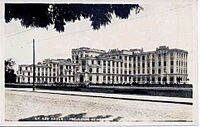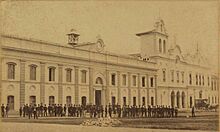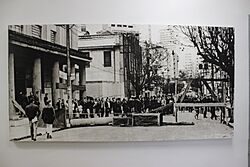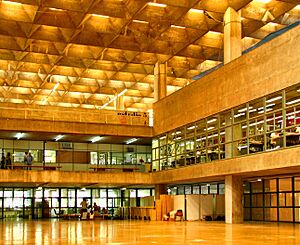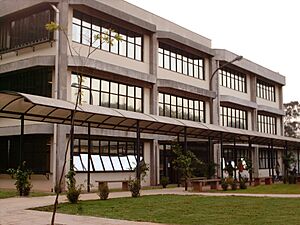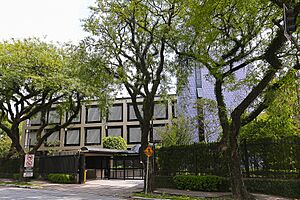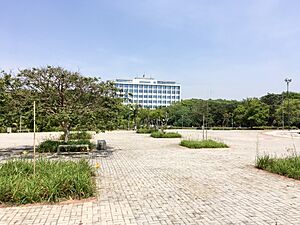University of São Paulo facts for kids
|
Universidade de São Paulo
|
|
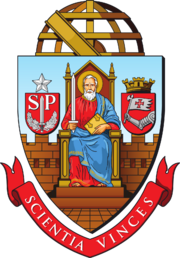
Coat of arms of the University of São Paulo
|
|
|
Other name
|
USP |
|---|---|
| Motto |
Scientia Vinces
|
|
Motto in English
|
"Through knowledge you will conquer" |
| Type | Public university |
| Established | 25 January 1934 |
| Budget | R$ 9.15 billion |
| Rector | Carlos Gilberto Carlotti Junior |
|
Academic staff
|
5,306 |
|
Administrative staff
|
12,607 |
| Students | 97,325 |
| Undergraduates | 58,752 |
| Postgraduates | 29,487 |
| Location |
São Paulo, Brazil
23°33′35″S 46°43′45″W / 23.55972°S 46.72917°W |
| Campus | Bauru, Lorena, Piracicaba, Pirassununga, Ribeirão Preto, Santos, São Carlos, São Paulo, São Sebastião |
| Colors | Primary blue, secondary blue and yellow |
 |
|
The University of São Paulo (also known as USP) is a very important public university in the Brazilian state of São Paulo. It is the largest public university in Brazil.
USP was started on January 25, 1934. It brought together schools that already existed in São Paulo. These included the Law School, the Polytechnic School, and the College of Agriculture. When the university was founded, a new part called the Faculty of Philosophy, Sciences, and Literature was also created. Today, USP teaches, researches, and helps the community in many different subjects. It offers a wide variety of courses. The university has eleven campuses. Four of these are in the city of São Paulo. The other campuses are in Bauru, Lorena, Piracicaba, Pirassununga, Ribeirão Preto, and two in São Carlos.
Many people who studied or taught at USP became important leaders. This includes 13 Brazilian presidents and members of the National Congress. Also, many founders and leaders of big Brazilian companies came from USP. In terms of research, USP is one of Brazil's biggest research places. It creates more than 25% of the scientific papers published by Brazilian researchers. These papers appear in top conferences and journals.
Contents
A Look at USP's History
After a time of change in São Paulo in 1933, some business people started a school called the Free School of Sociology and Politics (ELSP). Then, in 1934, the leader of São Paulo, Armando de Sales Oliveira, officially started the University of São Paulo (USP).
This was part of a bigger plan to make Brazil's schools and other important groups more modern. A key part of this plan was creating USP. Its main new part was the School of Philosophy, Sciences, and Languages. This school had professors from many European countries. The ELSP focused on training leaders for the government. USP, on the other hand, focused on training teachers, scientists, engineers, lawyers, and doctors.
Many famous professors from other countries came to teach at USP. They helped bring new ways of teaching and research to Brazil. These professors came from places like France, Germany, Russia, and Italy. They helped train new generations of scientists in Brazil. Since it started, USP has welcomed teachers and researchers from all over the world.
How USP Began
The University of São Paulo was formed by combining a new school with many older, well-known schools. The new school was the School of Philosophy, Sciences, and Languages (FFCL). It joined with existing schools like the Polytechnic School of Engineering (started in 1893) and the Luiz de Queiroz College of Agriculture (started in 1901). Other schools that joined included the Medical School (1912), the Law School (1827), and the School of Pharmacy and Dentistry (1898). The Institute of Astronomy, Geophysics, and Atmospheric Sciences (1886) and the School of Veterinary Medicine (1919) also became part of USP.
The FFCL helped bring all these different areas of study together. In 1934, the School of Physical Education was also created. This was the first public school for physical education in Brazil. It later became part of the university. In 1944, the Medical School opened its own public hospital. This hospital is called the Hospital das Clínicas da Universidade de São Paulo. In the same year, the School of Engineering of Sao Carlos (EESC) was also created. Over the years, many other research centers were added. For example, a second Medical School opened in Ribeirão Preto in 1952.
In the 1960s, many of USP's main offices moved to the City University Armando de Salles Oliveira in São Paulo. In 1963, the Heart Institute of the University of São Paulo was founded. After that, new institutes and schools were created. One example is the School of Journalism, Communications and Arts (ECA) in 1966. Over time, some of the university's older departments became their own separate schools or institutes. These include the Institute of Biomedical Sciences (ICB) and the Institute of Geosciences (IGc) in 1969.
Challenges and Growth
During the 1970s and 1980s, Brazil had a military government. During this time, many professors at USP faced difficulties. Some were forced to leave the country. This made it harder for scientific research to grow in Brazil. However, the government also encouraged more students to go to graduate school.
The university worked to bring back teachers and students who had been forced to leave. This happened in the early 1980s. Many professors returned to USP, even if they had to start in new positions. This helped the university to recover and grow again.
As the university recovered, new academic groups were formed. New schools and institutes were created. This led to new courses and research areas. The original School of Philosophy, Sciences, and Letters (FFCL) had many of its departments become separate units. For example, the Institute of Physics was one of the first to become its own institute.
In 2004, USP started the Institute of International Relations. This institute studies global topics like law, politics, and history. It has students and professors from Brazil and other countries. In 2005, a new School of Arts, Sciences, and Humanities (EACH) was built in the East Zone of São Paulo. This school offers different types of courses. In 2006, USP joined with another school, the School of Chemical Engineering (FAENQUIL), in Lorena. In 2007, a second Law School was opened in Ribeirão Preto.
What Students Learn at USP
| University rankings | |
|---|---|
| Global – Overall | |
| ARWU World | 101-150 (2022) |
| CWUR World | 109 (2023) |
| CWTS World | 12 (2023) |
| QS World | 108 (2026) |
| THE World | 201–250 (2023) |
| USNWR Global | =120 (2022-23) |
Today, USP has five hospitals. It offers 247 different programs for undergraduate students. It also has 239 programs for graduate students. The university has 24 museums and art galleries. About half a million people visit them each year. USP also has two theaters, a cinema, a TV channel, and an orchestra. The University of São Paulo welcomes students from all over the world. It works with groups like Erasmus Mundus to help students study abroad.
University Rankings
USP is known as one of the top universities in the world. In 2011, it was ranked first for the number of doctoral degrees it awarded. In 2013, Times Higher Education ranked USP among the top 70 universities for its reputation. The 2013 Academic Ranking of World Universities placed USP in the top 101–151 universities globally. In 2020, the CWTS Leiden Ranking put USP as the 7th best university in the world. The 2024 QS World University Rankings placed USP at 85th in the world. It is also ranked 1st in Latin America. As of 2021, USP was the first Latin American university to be ranked in the 201-250 group by the Times Higher Education World University Rankings.
Healthcare at USP

USP runs four hospitals. One of them is the University of São Paulo Medical School Public Hospital. This is the largest hospital complex in Latin America. It is a major place for medical students to learn and train. The hospitals are:
- University of São Paulo Medical School Public Hospital
- Heart Institute of the University of São Paulo
- Public Hospital of Ribeirão Preto Medical School
- Hospital de Reabilitação de Anomalias Craniofaciais – Centrinho
Library System
USP has 42 libraries. They are all managed by the Integrated Library System (SIB). This system also runs the university's online system, called DEDALUS.
DEDALUS is an online database. It lets students and researchers search all university libraries at once. It also connects to other online databases that the university uses. This makes it easier and faster for people to find information for their studies and research.
Museums and Art Galleries
The University of São Paulo has many museums and art galleries. Most of them are on the main campus in São Paulo city:
- Museu de Arte Contemporânea da Universidade de São Paulo (Museum of Contemporary Art)
- Museu Paulista (Historical Museum of São Paulo)
- Museu de Zoologia (Museum of Zoology)
- MAE-USP – Museu de Arqueologia e Etnologia (Museum of Archeology and Ethnology)
- Museu do Café Francisco Schmidt (Ribeirão Preto Campus)
How to Get Into USP
Brazilian students take an entrance exam called the vestibular. This exam is created by FUVEST (University Foundation for Vestibular). In 2012, over 159,000 students took the Fuvest exam for about 11,000 spots. The first part of the test is multiple-choice. It covers subjects like chemistry, physics, math, biology, geography, history, Portuguese, and English. The second part is a written test. It has more detailed questions specific to the student's chosen field of study. For example, engineering students get more physics, chemistry, and math questions. All students must answer in-depth Portuguese questions.
More recently, students can also get into USP by taking a national high school test called ENEM. This is done through the Unified Selection System (SISU). Each course decides how many spots are available for each way of getting in.
Students from other countries can come to USP through exchange programs. In 2012, USP welcomed over 2,300 exchange students. About one-third of these students studied humanities and social sciences. Another third studied engineering.
USP does not charge any tuition fees to its students, whether they are from Brazil or other countries. This is because the university gets its money from the state of São Paulo.
How USP is Organized
USP is like a collection of many independent schools, institutes, and colleges. Each one focuses on a different area of knowledge. There are 36 such units for teaching, research, and community help. Like most universities in Brazil, each unit can decide how to organize its courses. This sometimes means that different units might study similar things, which can lead to some overlap.
Each unit is divided into departments. A department usually focuses on one course or a specific research area. In units with only a few courses, departments might be responsible for just a part of a course. Because the university is so spread out, you might find similar departments in different units.
How USP is Managed
The main office of USP is called the Rectory. The main leader of the university is the Rector. Under the Rectory, there are four special offices called Pro-Rectorates. Each one handles a different part of the university's work:
- Undergraduate Pro-Rectorate (PRG): For students studying for their first degree.
- Post-Graduation Pro-Rectorate (PRPG): For students studying for master's or doctoral degrees.
- Pro-Rectory of Research (PRP): For all research activities.
- Pro-Rectory of Culture and Extension (PRC): For cultural activities and helping the community.
Recently, there has been talk about creating a new Pro-Rectorate for Student Assistance. Some people believe that helping students has not been a top priority for the university's leaders in the past.
More to Explore
- List of state universities in Brazil
- List of University of São Paulo alumni
- List of University of São Paulo faculty
- Rankings of universities in Brazil
- Universidade Estadual de Campinas (Unicamp)
- Universidade Estadual Paulista Júlio de Mesquita Filho (Unesp)
- Universities and Higher Education in Brazil
See also
 In Spanish: Universidad de São Paulo para niños
In Spanish: Universidad de São Paulo para niños




